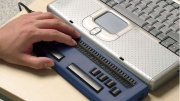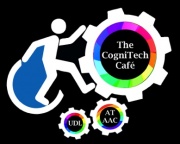User:Gayathri1524/Sandbox
Contents
ASSISTIVE TECHNOLOGY
Assistive technology (often abbreviated as AT) is any item, piece of equipment, software or product system that is used to increase, maintain, or improve the functional capabilities of individuals with disabilities, the technology needed to accomplish such tasks. Assistive technology[[1]] is an umbrella term that includes assistive, adaptive,and rehabilitative devices for people with disabilities and also includes the process used in selecting, locating, and using them. AT promotes greater independence by enabling people to perform tasks that they were formerly unable to accomplish, or had great difficulty accomplishing, by providing enhancements to, or changing methods of interacting with, the technology needed to accomplish such tasks.
Different dissabilities need different assistive technology.
AT can be low tech like communication boards made of cardboard or fuzzy felt. AT can be high tech such as special purpose computers. AT can be hardware such as prosthetics, attachment devices (mounting systems), and positioning devices. AT can be computer hardware, like special switches, keyboards, and pointing devices. AT can be computer software such as screen-readers or communication software. AT can be inclusive or specialized learning materials and curriculum aids. AT can be specialized curricular software. AT can be much more, including electronic devices, wheel chairs, walkers, braces, educational software, power lifts, pencil holders, eye-gaze, and head trackers.
Assistive technology for visual impairment
[[2]]
Many people with serious visual impairments live independently, using a wide range of tools and techniques.
Examples of assistive technology for visually impairment include the Canadian currency tactile feature, which a system of raised dots in one corner, based on Braille cells but not standard Braille. For general computer use access technology such as screen readers, screen magnifiers and refreshable Braille displays has been widely taken up along with standalone reading aids that integrate a scanner, optical character recognition (OCR) software, and speech software in a single machine. These function together without a separate PC.
Assistive technology for cognition
AT for cognition (ATC) is the use of technology (usually high tech) to augment and assistive cognitive processes such as attention, memory,
self-regulation, navigation, emotion recognition and management, planning, and sequencing activity. Systematic reviews of the field have found that the number of ATC are growing rapidly, but have focused on memory and planning, that there is emerging evidence for efficacy, that a lot of scope exists to develop new ATC. Examples of ATC include: NeuroPage which prompts users about meetings,Wakamaru, which provides companionship and reminds users to take medicine and calls for help if something is wrong, and telephone Reassurance systems.
Mobility impairment and wheelchairs
Wheelchairs are devices that can be manually propelled or electrically propelled and that include a seating system and are designed to be a substitute for the normal mobility that most people enjoy. Wheelchairs and other mobility devices allow people to perform mobility related activities of daily living which include feeding, toileting, dressing grooming and bathing. The devices comes in a number of variations where they can be propelled either by hand or by motors where the occupant uses electrical controls to manage motors and seating control actuators through a joystick, sip-and-puff control, or other input devices.
The Assistive Technology Industry Association
It is often abbreviated as ATIA IT is a not-for profit membership organization of manufacturers, sellers and providers of technology-based assistive devices and/or services.
ATIA members are active in providing assistive technology in a variety of fields including:
autism spectrum disorders
blindness and low vision
deafness and hard of hearing
computer access
communication disorders
mobility impairment
mounting systems
learning disabilities
cognitive disabilities
web accessibility
augmentative and alternative communication devices (AAC)
--Gayathri1524 (talk) 10:55, 19 November 2014 (UTC)GAYATHRI V S



